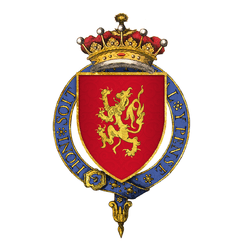Thomas FitzAlan, 12th Earl of Arundel

Thomas Fitzalan, 12th Earl of Arundel and 10th Earl of Surrey KG (13 October 1381 – 13 October 1415) was an English nobleman, one of the principals of the deposition of Richard II, and a major figure during the reign of Henry IV.
Lineage
He was the only surviving son of Richard FitzAlan, 11th Earl of Arundel and his first wife, Elizabeth de Bohun. When he was 16 his father was executed (1397) and his lands and titles forfeited. Fitzalan was given as ward to King Richard's half-brother John Holland, 1st Duke of Exeter, along with a large part of the Arundel estates. Holland greatly mistreated him, a matter FitzAlan would cruelly repay many years later.
Escape, exile, return and restoration
Eventually Fitzalan escaped from his guardian and joined his uncle Thomas Arundel, the deposed Archbishop of Canterbury, in exile. The two eventually joined with another exile, the King's cousin Henry Bolingbroke.
Fitzalan followed Henry in his return to England in July 1399, and in the following events which led to the deposition of King Richard II and Henry's crowning as King Henry IV. He functioned as butler at the coronation, and shortly afterward the new King restored him to his titles and estates. These included two notable Earldoms; those of Earl of Arundel and Earl of Surrey, and large estates in the Welsh Marches.
The Epiphany Rising
Early the next year a group of Barons who had been close to the deposed King Richard II revolted—known as the Epiphany Rising—amongst them Fitzalan' former guardian John Holland. The latter was captured by followers of Fitzalan's aunt Joan, Countess of Hereford, and at Fitzalan' behest was soon executed (some claim he was tortured first).
The rebellion of Owain Glyndwr in Wales
The next few years Fitzalan was much occupied by events in the Welsh marches, where he had to help deal with the revolt of Owain Glyndŵr which ran in full from 1400 to maybe 1412 but gained a great deal of early momentum until 1405. After the Battle of Shrewsbury in 1403 he was appointed to defend the Marches from further attacks along its full length and then focused on defeating Glyndwr in the northern March adjacent to North Wales.
Revolt in the North
In 1405 there was a revolt in the north of England, led by the Archbishop of York, Richard le Scrope, and the Earl of Norfolk, Thomas de Mowbray. Fitzalan was the head of the Commission which condemned the pair to death. This apparently led to a falling out between Fitzalan and his uncle, Archbishop Thomas Arundel, who objected to the execution of a fellow prelate.
Portuguese alliance and marriages
King Henry's sister, Philippa of Lancaster, had married King John I of Portugal, and to further cement the alliance between England and Portugal, Fitzalan married Beatrice, the illegitimate daughter of King John. The wedding took place in London on 26 November 1405, with King Henry IV in attendance.
Welsh conflicts and alliance with Burgundy
In the following years Fitzalan again had to help suppress revolts in Wales and the Welsh Marches. Politically, Fitzalan allied himself with the King's half-brothers the Beauforts, and when Thomas Beaufort, 1st Duke of Exeter was appointed Chancellor in 1410, Fitzalan became one of the King's principal councillors. Beaufort favored an alliance with Burgundy, and Fitzalan was one of the leaders of those sent to help fight the rival Armagnac faction in France. Sometime in this period Fitzalan was made a Knight of the Garter.
Career during reign of King Henry V
In 1412 the Beauforts lost power, and Fitzalan retired to his estates until the next year, when King Henry IV died. His son, King Henry V restored Fitzalan to a place of influence, immediately appointing him Lord Treasurer, as well as constable of Dover Castle and Warden of the Cinque Ports. Fitzalan was one of the initial commanders of Henry V's 1415 French campaign, but at the siege of Harfleur he, along with many others, fell ill and had to return to England. He never recovered, and died not long afterwards.
Ancestry
Succession
Fitzalan left no legitimate children. The castle and lordship of Arundel was inherited by his cousin John Fitzalan, 13th Earl of Arundel. The Earldom of Surrey fell into abeyance (or went extinct; authorities differ on this matter). The rest of his property was split amongst his three surviving sisters.
References
 Stephen, Leslie, ed. (1889). "Fitzalan, Thomas". Dictionary of National Biography 19. London: Smith, Elder & Co.
Stephen, Leslie, ed. (1889). "Fitzalan, Thomas". Dictionary of National Biography 19. London: Smith, Elder & Co.
| Honorary titles | ||
|---|---|---|
| Preceded by The Prince of Wales |
Lord Warden of the Cinque Ports 1412–1415 |
Succeeded by The Duke of Gloucester |
| Political offices | ||
| Preceded by Sir John Pelham |
Lord Treasurer 1413–1415 |
Succeeded by Sir Hugh Mortimer |
| Peerage of England | ||
| Preceded by Richard Fitzalan |
Earl of Arundel 1399–1415 |
Succeeded by John FitzAlan |
| Earl of Surrey (1st creation) 1400–1415 |
Extinct | |
Note: Some sources do not include the first seven earls in their list of Earls of Arundel (see Earl of Arundel). In such sources this Earl is the fifth.